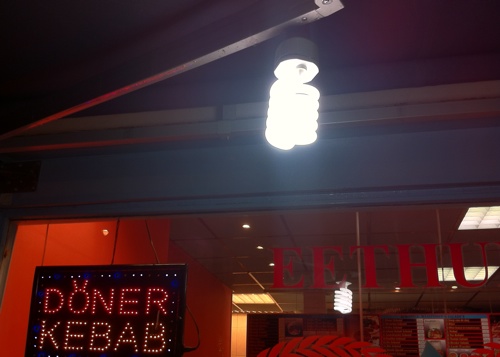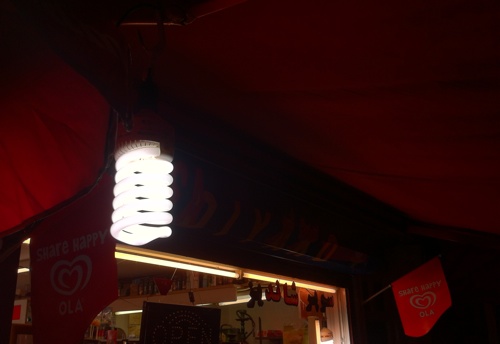Catching up with the global south...
Almost 6 year ago (on the first of january 2007) i started taking an interest in the use of Compact Fluorescent Lights (CFLs) as exterior lightening. I first noticed this use of this type op lightbulbs on a new years day stroll to the recently bombed out southern suburbs of Beirut. A large number shops and market stalls has improvised lamps made from large CFLs. The next day i observed the same while visiting a number of recently destroyed villages along the Lebanese/Israeli border.
While this kind of eco-light bulbs where still relatively new and rare in north-west Europe at the time, their sudden appearance in Lebanon made a lot of sense: The Lebanon’s electricity generating capacity had been severely reduced by israeli air strikes during the previous summer’s war and in a situation where there is insufficient supply of electricity energy efficiency is a simple necessity (as opposed to the luxury it represents in the global north).
I later encountered large CFLs as (often improvised) exterior lighting in a large variety of places outside of Europe: In fast growing economies like China, Brazil and Indonesia (where supply of electricity does not manage to keep with the rapid growth of demand) and places like Cuba, Iran, Egypt or Syria, where the distribution infrastructure is often improvised and thus vulnerable to excessive demand).
Whatever the reason it appears that all of these countries were leapfrogging the developed world in use of energy efficient lightening, not because they cared so much about their carbon footprint, but out of sheer necessity (which of course nicely contrasts our self perception as moral champions of energy efficiency in the global debate about climate change).
In this context it is somewhat refreshing to notice that apparently we have started to catch up with the developing world. On my bike ride home from work the day before yesterday i noticed a number of stores (run by immigrants) that used CFLs for exterior lighting in pretty much the same way that they have been using them in Lebanon since 2007:


i am pretty sure we will see much more of this type of immigrant driven technology transfer from the periphery to the center in the years to come…
